An Analysis of Criminal Justice, Disorder, and Police in Law
VerifiedAdded on 2022/11/03
|8
|1636
|384
Essay
AI Summary
This essay delves into the influence of criminal justice models, specifically the crime control and due process models, as conceptualized by Herbert Packer. It examines the assertions within the criminal justice system, emphasizing crime repression, victim rights, and police powers. The essay further explores the relationship between neighborhood disorder and crime, focusing on the broken windows thesis and its impact on crime control policies. It defines the role of police in addressing disorder, differentiating between police and sheriff's departments. Social disorganization theory is also discussed, linking crime rates to ecological factors. The essay concludes by analyzing the role of politicians in addressing crime and social disorganization, including strategies like stricter alcohol policies and intelligent police deployment.
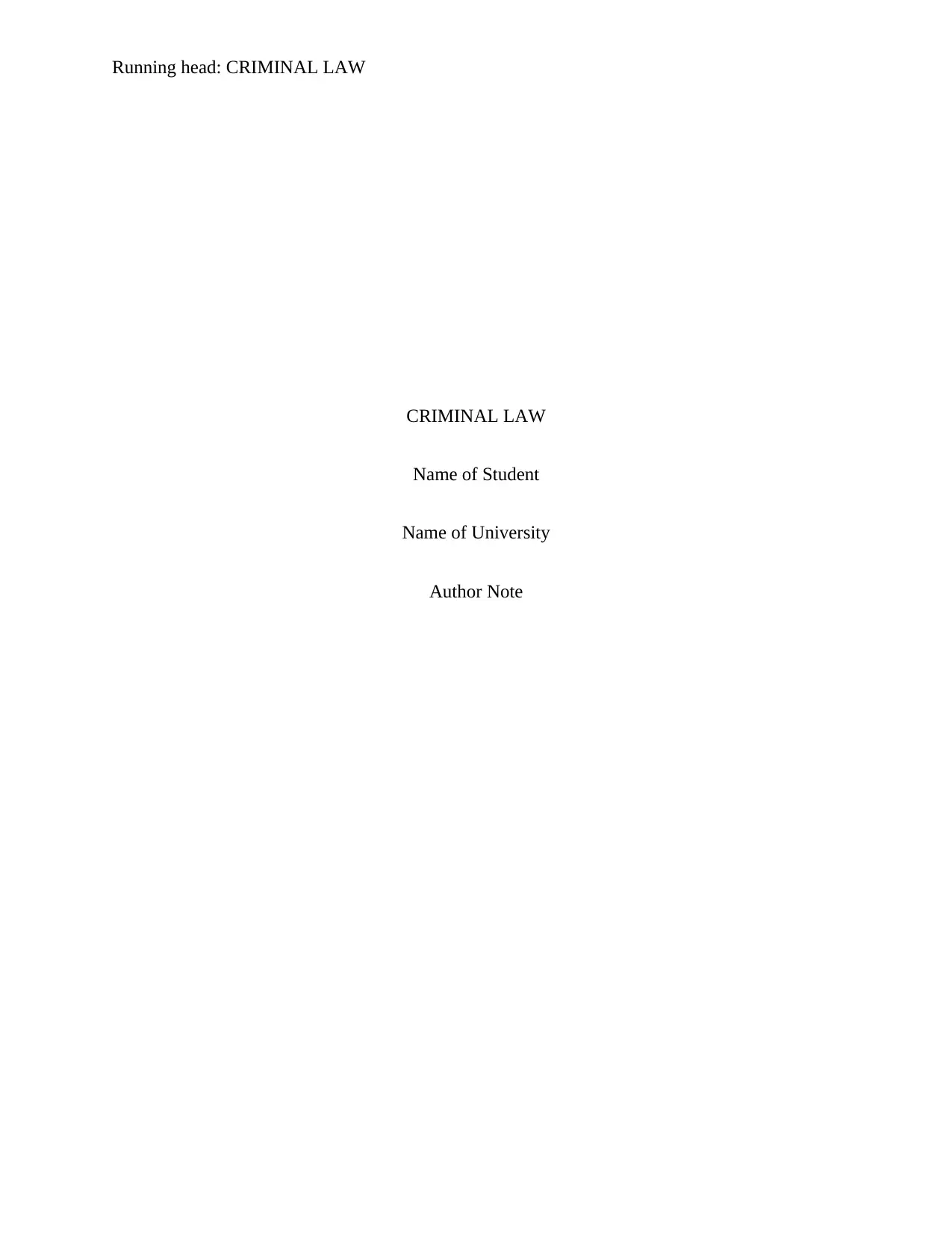
Running head: CRIMINAL LAW
CRIMINAL LAW
Name of Student
Name of University
Author Note
CRIMINAL LAW
Name of Student
Name of University
Author Note
Paraphrase This Document
Need a fresh take? Get an instant paraphrase of this document with our AI Paraphraser
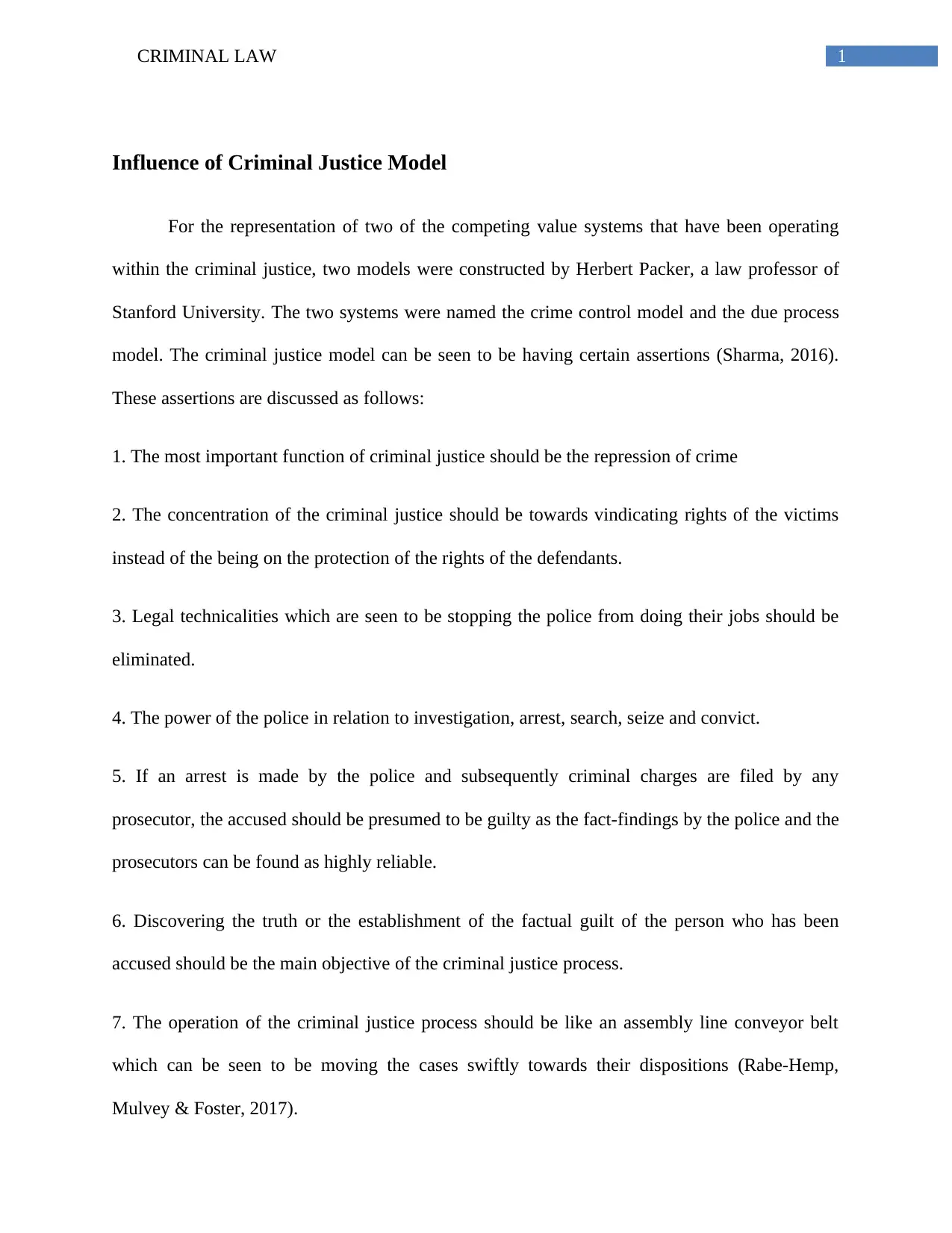
1CRIMINAL LAW
Influence of Criminal Justice Model
For the representation of two of the competing value systems that have been operating
within the criminal justice, two models were constructed by Herbert Packer, a law professor of
Stanford University. The two systems were named the crime control model and the due process
model. The criminal justice model can be seen to be having certain assertions (Sharma, 2016).
These assertions are discussed as follows:
1. The most important function of criminal justice should be the repression of crime
2. The concentration of the criminal justice should be towards vindicating rights of the victims
instead of the being on the protection of the rights of the defendants.
3. Legal technicalities which are seen to be stopping the police from doing their jobs should be
eliminated.
4. The power of the police in relation to investigation, arrest, search, seize and convict.
5. If an arrest is made by the police and subsequently criminal charges are filed by any
prosecutor, the accused should be presumed to be guilty as the fact-findings by the police and the
prosecutors can be found as highly reliable.
6. Discovering the truth or the establishment of the factual guilt of the person who has been
accused should be the main objective of the criminal justice process.
7. The operation of the criminal justice process should be like an assembly line conveyor belt
which can be seen to be moving the cases swiftly towards their dispositions (Rabe-Hemp,
Mulvey & Foster, 2017).
Influence of Criminal Justice Model
For the representation of two of the competing value systems that have been operating
within the criminal justice, two models were constructed by Herbert Packer, a law professor of
Stanford University. The two systems were named the crime control model and the due process
model. The criminal justice model can be seen to be having certain assertions (Sharma, 2016).
These assertions are discussed as follows:
1. The most important function of criminal justice should be the repression of crime
2. The concentration of the criminal justice should be towards vindicating rights of the victims
instead of the being on the protection of the rights of the defendants.
3. Legal technicalities which are seen to be stopping the police from doing their jobs should be
eliminated.
4. The power of the police in relation to investigation, arrest, search, seize and convict.
5. If an arrest is made by the police and subsequently criminal charges are filed by any
prosecutor, the accused should be presumed to be guilty as the fact-findings by the police and the
prosecutors can be found as highly reliable.
6. Discovering the truth or the establishment of the factual guilt of the person who has been
accused should be the main objective of the criminal justice process.
7. The operation of the criminal justice process should be like an assembly line conveyor belt
which can be seen to be moving the cases swiftly towards their dispositions (Rabe-Hemp,
Mulvey & Foster, 2017).
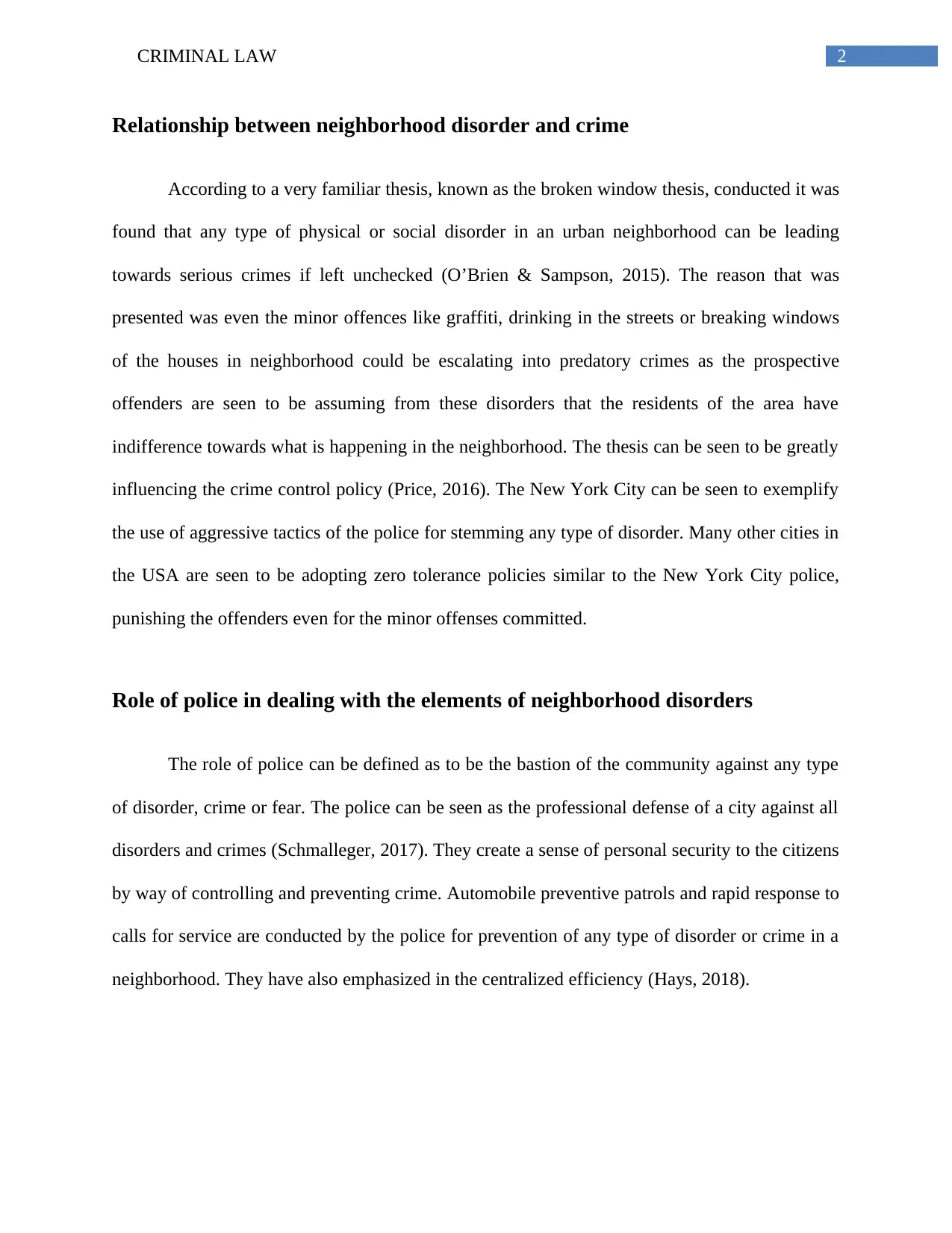
2CRIMINAL LAW
Relationship between neighborhood disorder and crime
According to a very familiar thesis, known as the broken window thesis, conducted it was
found that any type of physical or social disorder in an urban neighborhood can be leading
towards serious crimes if left unchecked (O’Brien & Sampson, 2015). The reason that was
presented was even the minor offences like graffiti, drinking in the streets or breaking windows
of the houses in neighborhood could be escalating into predatory crimes as the prospective
offenders are seen to be assuming from these disorders that the residents of the area have
indifference towards what is happening in the neighborhood. The thesis can be seen to be greatly
influencing the crime control policy (Price, 2016). The New York City can be seen to exemplify
the use of aggressive tactics of the police for stemming any type of disorder. Many other cities in
the USA are seen to be adopting zero tolerance policies similar to the New York City police,
punishing the offenders even for the minor offenses committed.
Role of police in dealing with the elements of neighborhood disorders
The role of police can be defined as to be the bastion of the community against any type
of disorder, crime or fear. The police can be seen as the professional defense of a city against all
disorders and crimes (Schmalleger, 2017). They create a sense of personal security to the citizens
by way of controlling and preventing crime. Automobile preventive patrols and rapid response to
calls for service are conducted by the police for prevention of any type of disorder or crime in a
neighborhood. They have also emphasized in the centralized efficiency (Hays, 2018).
Relationship between neighborhood disorder and crime
According to a very familiar thesis, known as the broken window thesis, conducted it was
found that any type of physical or social disorder in an urban neighborhood can be leading
towards serious crimes if left unchecked (O’Brien & Sampson, 2015). The reason that was
presented was even the minor offences like graffiti, drinking in the streets or breaking windows
of the houses in neighborhood could be escalating into predatory crimes as the prospective
offenders are seen to be assuming from these disorders that the residents of the area have
indifference towards what is happening in the neighborhood. The thesis can be seen to be greatly
influencing the crime control policy (Price, 2016). The New York City can be seen to exemplify
the use of aggressive tactics of the police for stemming any type of disorder. Many other cities in
the USA are seen to be adopting zero tolerance policies similar to the New York City police,
punishing the offenders even for the minor offenses committed.
Role of police in dealing with the elements of neighborhood disorders
The role of police can be defined as to be the bastion of the community against any type
of disorder, crime or fear. The police can be seen as the professional defense of a city against all
disorders and crimes (Schmalleger, 2017). They create a sense of personal security to the citizens
by way of controlling and preventing crime. Automobile preventive patrols and rapid response to
calls for service are conducted by the police for prevention of any type of disorder or crime in a
neighborhood. They have also emphasized in the centralized efficiency (Hays, 2018).
⊘ This is a preview!⊘
Do you want full access?
Subscribe today to unlock all pages.

Trusted by 1+ million students worldwide
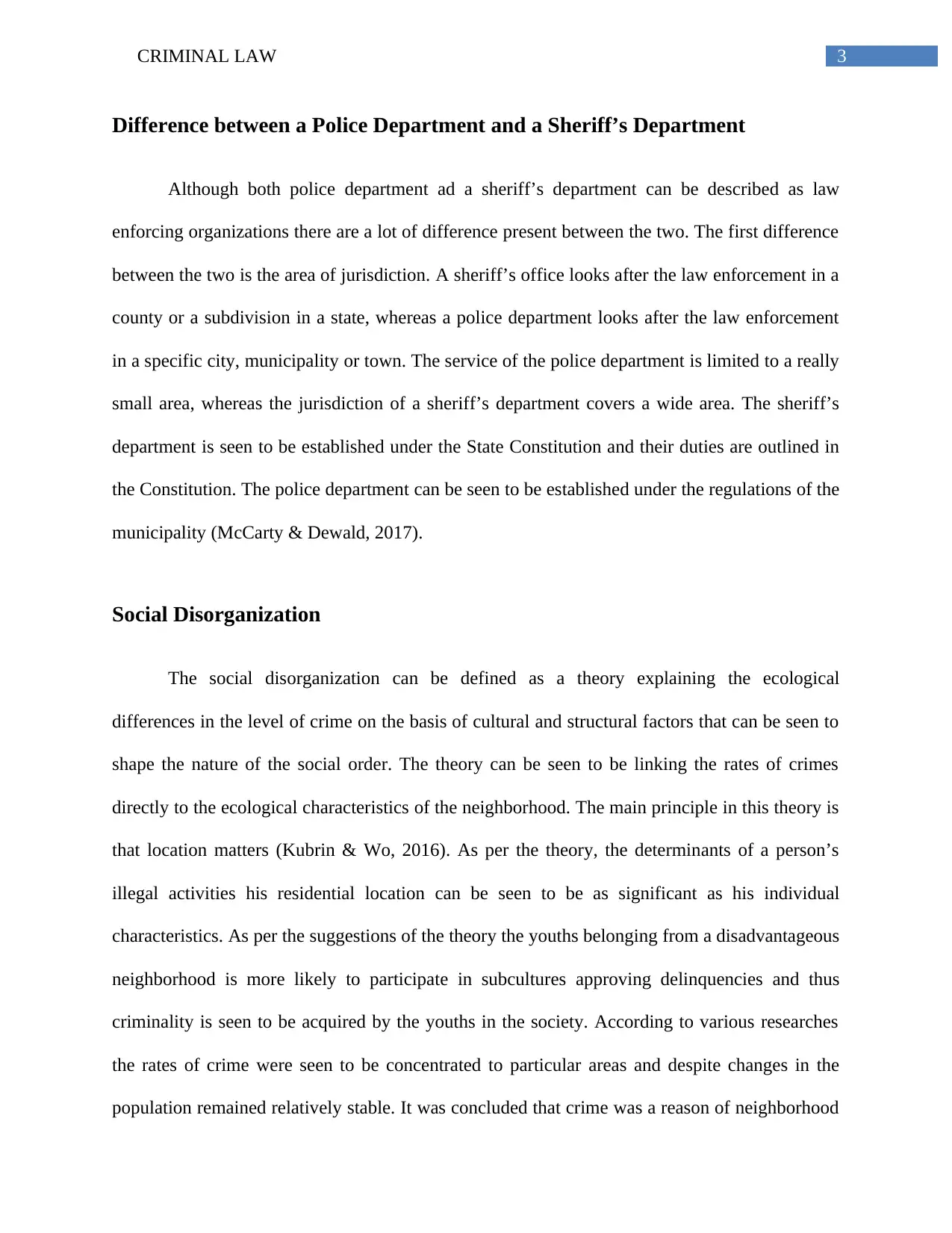
3CRIMINAL LAW
Difference between a Police Department and a Sheriff’s Department
Although both police department ad a sheriff’s department can be described as law
enforcing organizations there are a lot of difference present between the two. The first difference
between the two is the area of jurisdiction. A sheriff’s office looks after the law enforcement in a
county or a subdivision in a state, whereas a police department looks after the law enforcement
in a specific city, municipality or town. The service of the police department is limited to a really
small area, whereas the jurisdiction of a sheriff’s department covers a wide area. The sheriff’s
department is seen to be established under the State Constitution and their duties are outlined in
the Constitution. The police department can be seen to be established under the regulations of the
municipality (McCarty & Dewald, 2017).
Social Disorganization
The social disorganization can be defined as a theory explaining the ecological
differences in the level of crime on the basis of cultural and structural factors that can be seen to
shape the nature of the social order. The theory can be seen to be linking the rates of crimes
directly to the ecological characteristics of the neighborhood. The main principle in this theory is
that location matters (Kubrin & Wo, 2016). As per the theory, the determinants of a person’s
illegal activities his residential location can be seen to be as significant as his individual
characteristics. As per the suggestions of the theory the youths belonging from a disadvantageous
neighborhood is more likely to participate in subcultures approving delinquencies and thus
criminality is seen to be acquired by the youths in the society. According to various researches
the rates of crime were seen to be concentrated to particular areas and despite changes in the
population remained relatively stable. It was concluded that crime was a reason of neighborhood
Difference between a Police Department and a Sheriff’s Department
Although both police department ad a sheriff’s department can be described as law
enforcing organizations there are a lot of difference present between the two. The first difference
between the two is the area of jurisdiction. A sheriff’s office looks after the law enforcement in a
county or a subdivision in a state, whereas a police department looks after the law enforcement
in a specific city, municipality or town. The service of the police department is limited to a really
small area, whereas the jurisdiction of a sheriff’s department covers a wide area. The sheriff’s
department is seen to be established under the State Constitution and their duties are outlined in
the Constitution. The police department can be seen to be established under the regulations of the
municipality (McCarty & Dewald, 2017).
Social Disorganization
The social disorganization can be defined as a theory explaining the ecological
differences in the level of crime on the basis of cultural and structural factors that can be seen to
shape the nature of the social order. The theory can be seen to be linking the rates of crimes
directly to the ecological characteristics of the neighborhood. The main principle in this theory is
that location matters (Kubrin & Wo, 2016). As per the theory, the determinants of a person’s
illegal activities his residential location can be seen to be as significant as his individual
characteristics. As per the suggestions of the theory the youths belonging from a disadvantageous
neighborhood is more likely to participate in subcultures approving delinquencies and thus
criminality is seen to be acquired by the youths in the society. According to various researches
the rates of crime were seen to be concentrated to particular areas and despite changes in the
population remained relatively stable. It was concluded that crime was a reason of neighborhood
Paraphrase This Document
Need a fresh take? Get an instant paraphrase of this document with our AI Paraphraser
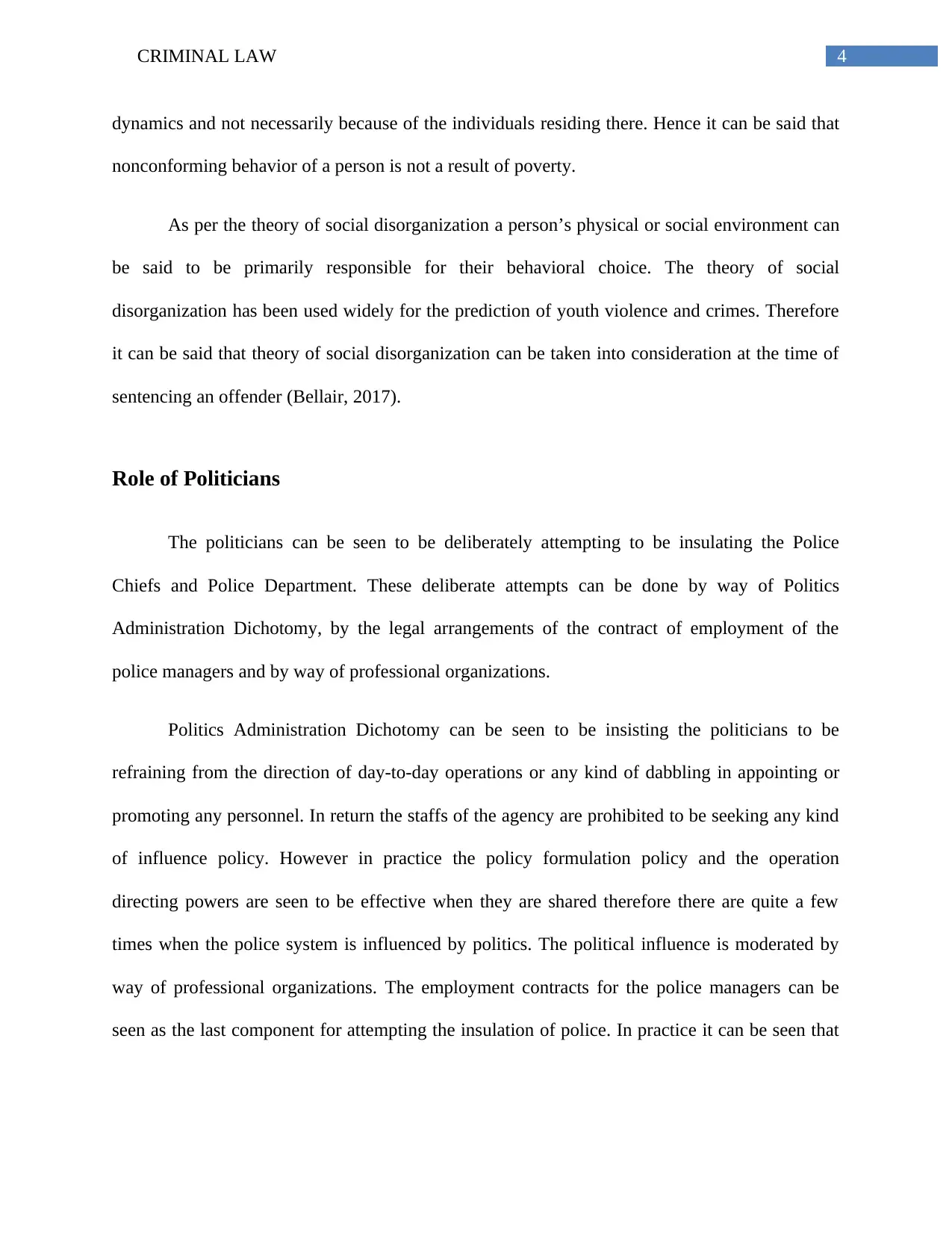
4CRIMINAL LAW
dynamics and not necessarily because of the individuals residing there. Hence it can be said that
nonconforming behavior of a person is not a result of poverty.
As per the theory of social disorganization a person’s physical or social environment can
be said to be primarily responsible for their behavioral choice. The theory of social
disorganization has been used widely for the prediction of youth violence and crimes. Therefore
it can be said that theory of social disorganization can be taken into consideration at the time of
sentencing an offender (Bellair, 2017).
Role of Politicians
The politicians can be seen to be deliberately attempting to be insulating the Police
Chiefs and Police Department. These deliberate attempts can be done by way of Politics
Administration Dichotomy, by the legal arrangements of the contract of employment of the
police managers and by way of professional organizations.
Politics Administration Dichotomy can be seen to be insisting the politicians to be
refraining from the direction of day-to-day operations or any kind of dabbling in appointing or
promoting any personnel. In return the staffs of the agency are prohibited to be seeking any kind
of influence policy. However in practice the policy formulation policy and the operation
directing powers are seen to be effective when they are shared therefore there are quite a few
times when the police system is influenced by politics. The political influence is moderated by
way of professional organizations. The employment contracts for the police managers can be
seen as the last component for attempting the insulation of police. In practice it can be seen that
dynamics and not necessarily because of the individuals residing there. Hence it can be said that
nonconforming behavior of a person is not a result of poverty.
As per the theory of social disorganization a person’s physical or social environment can
be said to be primarily responsible for their behavioral choice. The theory of social
disorganization has been used widely for the prediction of youth violence and crimes. Therefore
it can be said that theory of social disorganization can be taken into consideration at the time of
sentencing an offender (Bellair, 2017).
Role of Politicians
The politicians can be seen to be deliberately attempting to be insulating the Police
Chiefs and Police Department. These deliberate attempts can be done by way of Politics
Administration Dichotomy, by the legal arrangements of the contract of employment of the
police managers and by way of professional organizations.
Politics Administration Dichotomy can be seen to be insisting the politicians to be
refraining from the direction of day-to-day operations or any kind of dabbling in appointing or
promoting any personnel. In return the staffs of the agency are prohibited to be seeking any kind
of influence policy. However in practice the policy formulation policy and the operation
directing powers are seen to be effective when they are shared therefore there are quite a few
times when the police system is influenced by politics. The political influence is moderated by
way of professional organizations. The employment contracts for the police managers can be
seen as the last component for attempting the insulation of police. In practice it can be seen that
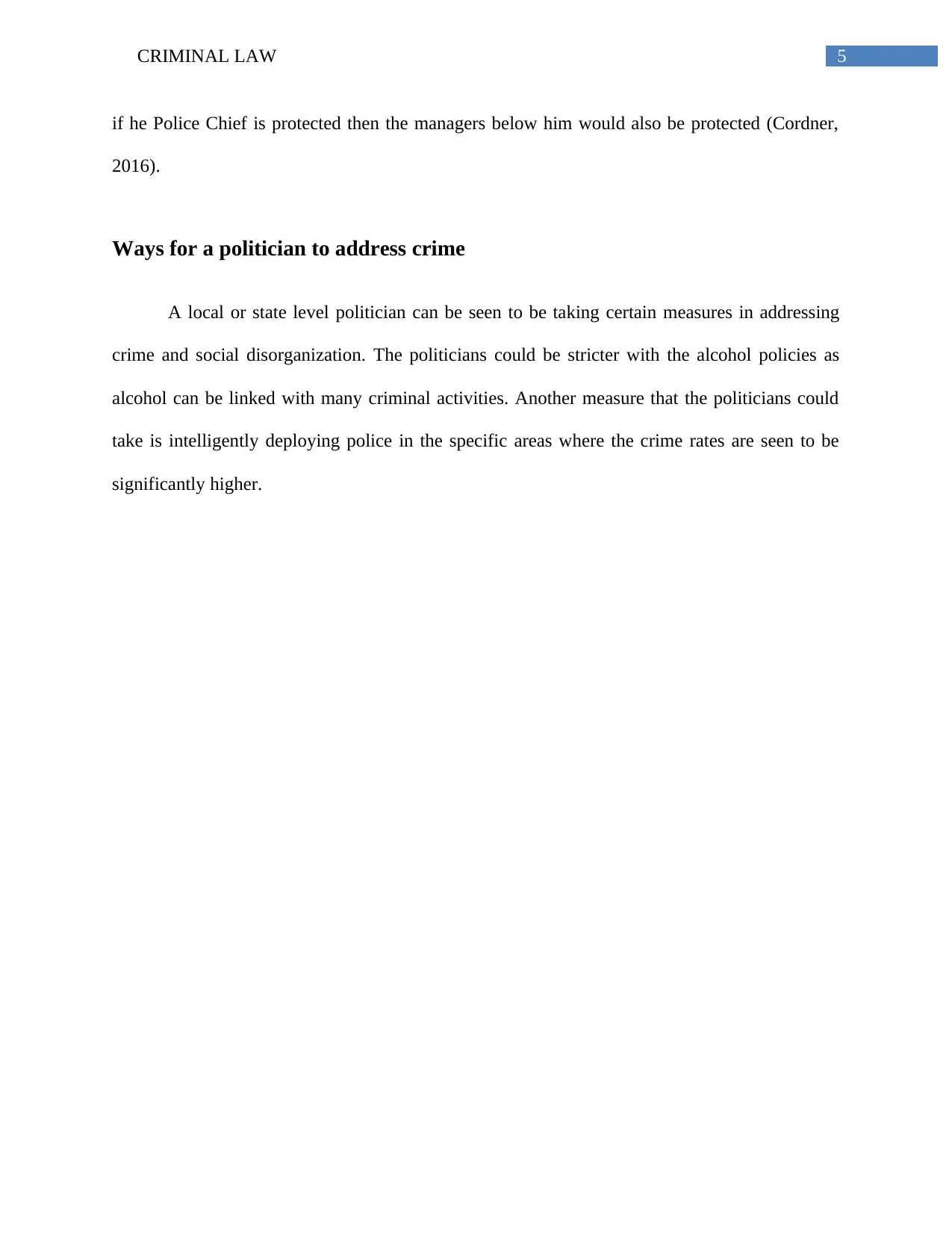
5CRIMINAL LAW
if he Police Chief is protected then the managers below him would also be protected (Cordner,
2016).
Ways for a politician to address crime
A local or state level politician can be seen to be taking certain measures in addressing
crime and social disorganization. The politicians could be stricter with the alcohol policies as
alcohol can be linked with many criminal activities. Another measure that the politicians could
take is intelligently deploying police in the specific areas where the crime rates are seen to be
significantly higher.
if he Police Chief is protected then the managers below him would also be protected (Cordner,
2016).
Ways for a politician to address crime
A local or state level politician can be seen to be taking certain measures in addressing
crime and social disorganization. The politicians could be stricter with the alcohol policies as
alcohol can be linked with many criminal activities. Another measure that the politicians could
take is intelligently deploying police in the specific areas where the crime rates are seen to be
significantly higher.
⊘ This is a preview!⊘
Do you want full access?
Subscribe today to unlock all pages.

Trusted by 1+ million students worldwide
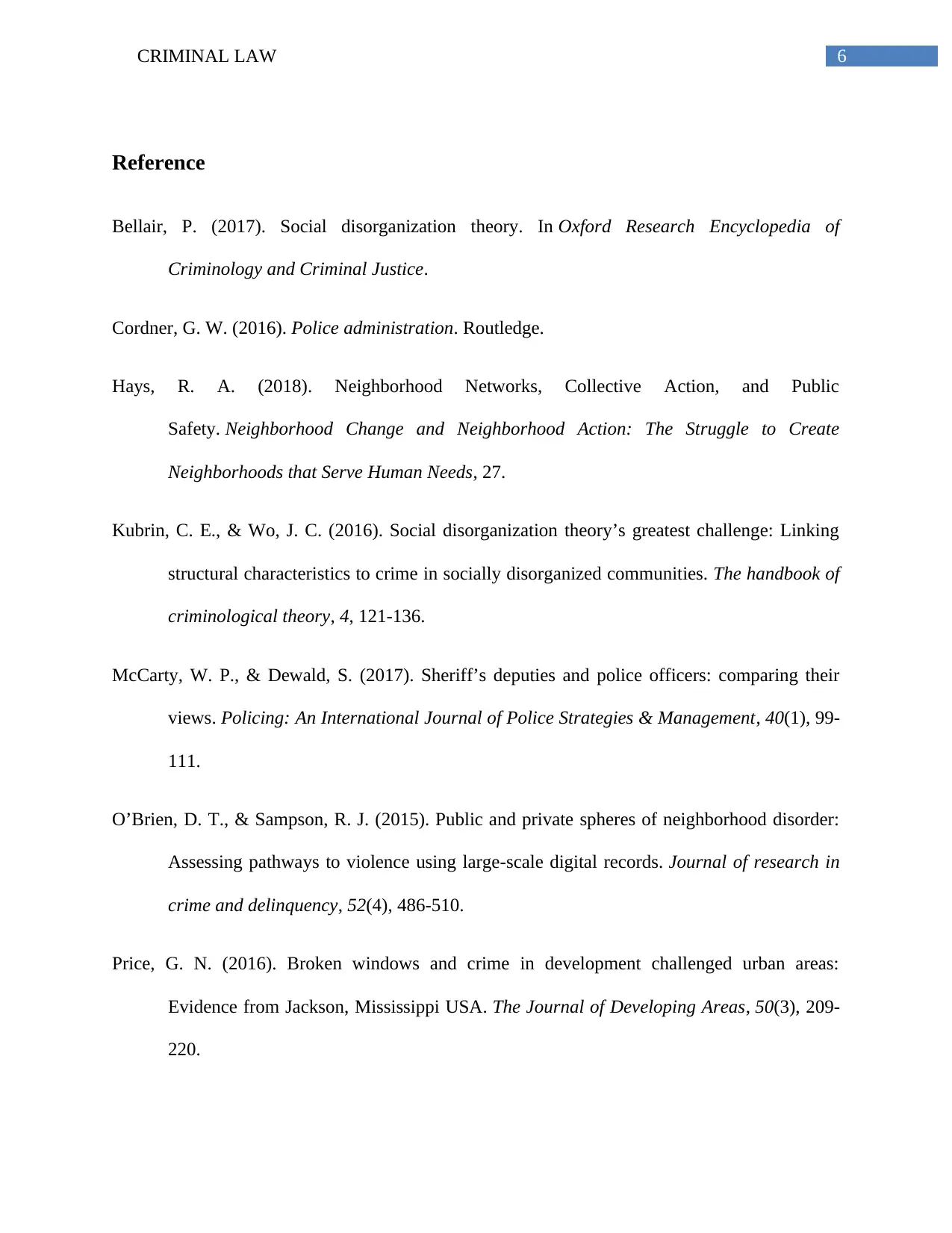
6CRIMINAL LAW
Reference
Bellair, P. (2017). Social disorganization theory. In Oxford Research Encyclopedia of
Criminology and Criminal Justice.
Cordner, G. W. (2016). Police administration. Routledge.
Hays, R. A. (2018). Neighborhood Networks, Collective Action, and Public
Safety. Neighborhood Change and Neighborhood Action: The Struggle to Create
Neighborhoods that Serve Human Needs, 27.
Kubrin, C. E., & Wo, J. C. (2016). Social disorganization theory’s greatest challenge: Linking
structural characteristics to crime in socially disorganized communities. The handbook of
criminological theory, 4, 121-136.
McCarty, W. P., & Dewald, S. (2017). Sheriff’s deputies and police officers: comparing their
views. Policing: An International Journal of Police Strategies & Management, 40(1), 99-
111.
O’Brien, D. T., & Sampson, R. J. (2015). Public and private spheres of neighborhood disorder:
Assessing pathways to violence using large-scale digital records. Journal of research in
crime and delinquency, 52(4), 486-510.
Price, G. N. (2016). Broken windows and crime in development challenged urban areas:
Evidence from Jackson, Mississippi USA. The Journal of Developing Areas, 50(3), 209-
220.
Reference
Bellair, P. (2017). Social disorganization theory. In Oxford Research Encyclopedia of
Criminology and Criminal Justice.
Cordner, G. W. (2016). Police administration. Routledge.
Hays, R. A. (2018). Neighborhood Networks, Collective Action, and Public
Safety. Neighborhood Change and Neighborhood Action: The Struggle to Create
Neighborhoods that Serve Human Needs, 27.
Kubrin, C. E., & Wo, J. C. (2016). Social disorganization theory’s greatest challenge: Linking
structural characteristics to crime in socially disorganized communities. The handbook of
criminological theory, 4, 121-136.
McCarty, W. P., & Dewald, S. (2017). Sheriff’s deputies and police officers: comparing their
views. Policing: An International Journal of Police Strategies & Management, 40(1), 99-
111.
O’Brien, D. T., & Sampson, R. J. (2015). Public and private spheres of neighborhood disorder:
Assessing pathways to violence using large-scale digital records. Journal of research in
crime and delinquency, 52(4), 486-510.
Price, G. N. (2016). Broken windows and crime in development challenged urban areas:
Evidence from Jackson, Mississippi USA. The Journal of Developing Areas, 50(3), 209-
220.
Paraphrase This Document
Need a fresh take? Get an instant paraphrase of this document with our AI Paraphraser
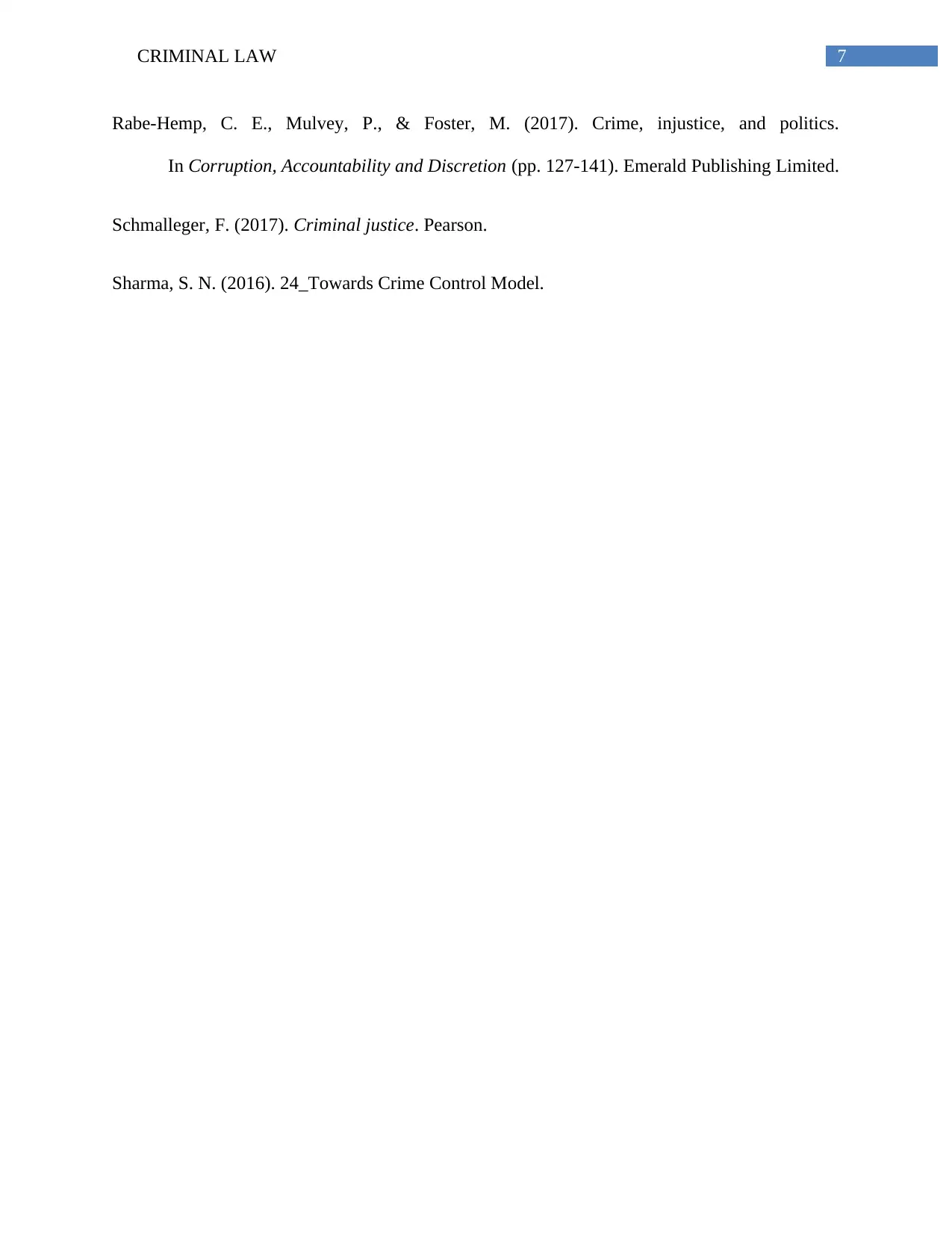
7CRIMINAL LAW
Rabe-Hemp, C. E., Mulvey, P., & Foster, M. (2017). Crime, injustice, and politics.
In Corruption, Accountability and Discretion (pp. 127-141). Emerald Publishing Limited.
Schmalleger, F. (2017). Criminal justice. Pearson.
Sharma, S. N. (2016). 24_Towards Crime Control Model.
Rabe-Hemp, C. E., Mulvey, P., & Foster, M. (2017). Crime, injustice, and politics.
In Corruption, Accountability and Discretion (pp. 127-141). Emerald Publishing Limited.
Schmalleger, F. (2017). Criminal justice. Pearson.
Sharma, S. N. (2016). 24_Towards Crime Control Model.
1 out of 8
Related Documents
Your All-in-One AI-Powered Toolkit for Academic Success.
+13062052269
info@desklib.com
Available 24*7 on WhatsApp / Email
![[object Object]](/_next/static/media/star-bottom.7253800d.svg)
Unlock your academic potential
Copyright © 2020–2025 A2Z Services. All Rights Reserved. Developed and managed by ZUCOL.




